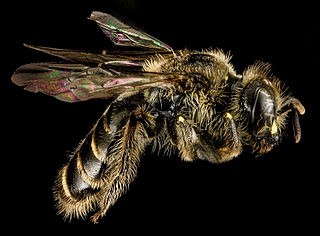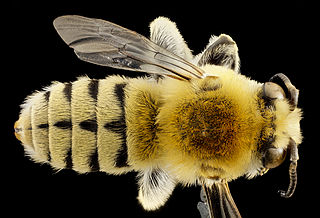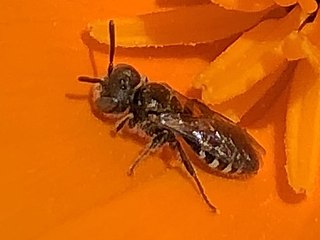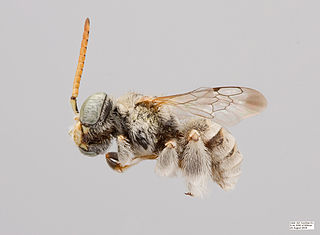Philip Hunter Timberlake (1883-1981) was one of the most prolific American entomologists of the 20th century. He was born on June 5, 1883, in Bethel, Maine, and died in 1981 in Riverside, California, where he had served as an Associate Entomologist in the Department of Entomology of the University of California, Riverside.

The bee subfamily Panurginae is a diverse lineage of 33 genera in 7 tribes. They are particularly diverse in the New World, though scarce in the tropics, and in the Old World they can be found primarily in the Palaearctic and Africa, but absent from Australia and tropical Asia. They tend to be associated with xeric or sandy habitats.

Perdita is a large genus of small bees native to North America, particularly diverse in the desert regions of the United States and Mexico. There are over 600 currently recognized species of Perdita, plus more than 100 additional subspecies and many more species that remain undescribed. Perdita are usually quite small and often brightly colored with metallic reflections and/or yellow or white markings, and among the few lineages of bees incapable of stinging. The genus was extensively treated by P.H. Timberlake who, in addition to T.D.A. Cockerell, described most of the known species. Most species are extreme specialists (oligoleges) with respect to pollen and will only collect pollen from a few closely related species or genera of plants. Many species in this genus are called fairy bees.

Trachusa perdita, the California leafcutting bee, is a species of bee in the family Megachilidae.

Macrotera portalis is a species of communal, ground nesting, partially bivoltine bees found in arid grasslands and desert regions of North America. An oligolectic bee, M. portalis gathers pollen only from plants in the genus Sphaeralcea and has patterns of seasonal emergence to survive the harsh conditions of the desert, with emergence delayed until monsoon rains arrive.

Macrotera is a genus of bees native to North America, particularly diverse in the desert regions of the United States and Mexico. According to Wilson and Carril, there are "around 30" species of Macrotera. Macrotera are small to medium sized and often black or reddish in coloration. The genus was treated by P.H. Timberlake who, in addition to T.D.A. Cockerell, described most of the known species. Macrotera used to be considered part of the genus Perdita but was split apart by C.D. Michener in 2000. Most species are extreme specialists (oligoleges) with respect to pollen and will only collect pollen from a few closely related species or genera of plants, particularly the plant genus Sphaeralcea and various Cactaceae.
Perdita scutellaris is a bee species from California in the United States. It is only found in sand dune habitats or other sandy areas. It is oligolectic, collecting pollen only from plants in the genus Tiquilia.

Calliopsis is a genus of panurgine bees in the family Andrenidae. There are over 80 described species distributed throughout the western hemisphere.

Habropoda is a genus of anthophorine bees in the family Apidae. There are at least 50 described species in Habropoda.
Perdita coreopsidis is a species of bee in the family Andrenidae. It is found in Central America and North America.

Perdita interrupta is a species of bee in the family Andrenidae. It is found in North America.

Anthophorula is a genus of bees in the family Apidae. There are more than 60 described species in Anthophorula.

Perdita californica is a species of bee in the family Andrenidae. It is found in Central America and North America.
Perdita koebelei is a species of bee in the family Andrenidae. It is found in North America.
Perdita punctosignata is a species of bee in the family Andrenidae. It is found in Central America and North America.

Protandrena is a genus of mining bees in the family Andrenidae. Depending upon whose definition of the genus one follows, there are anywhere from 50 to 180 described species in Protandrena; traditional classifications recognize 7 subgenera, some of which are sometimes elevated to genus rank, and other classifications place many of these species in the related genus Pseudopanurgus (e.g.), leaving Protandrena with a much smaller constituency. In the most inclusive definition, they are found from Canada through Argentina. However, there is current disagreement whether the Protandrena in South America belong to different genera, in which case the genus extends only as far south as Panama. They are solitary bees, but some species nest in aggregates. They prefer to nest in sunny areas with sparse vegetation. The underground nests have cells lined with a chemical substance. This "wallpaper" acts as a barrier between fungi and bacteria. The eggs hatch, the larvae develop, and then overwinter as mature larvae with hardened skinThey are primarily active from May to October, but have been noted to be active in April in the region six of the United States.

Perdita sexmaculata is a species of bee in the family Andrenidae. It is found in Central America and North America.
Perdita meconis, the Mojave poppy bee, is a rare bee species that was described in 1993. The Mojave poppy bee has been petitioned for protection under the Endangered Species Act due to pressures in their native range such as invasive species, habitat fragmentation, gypsum mining, and climate change.










